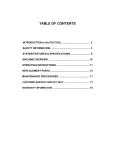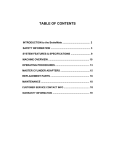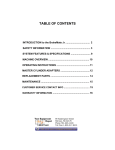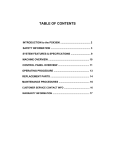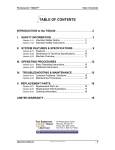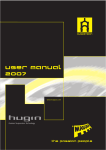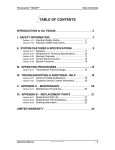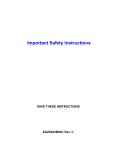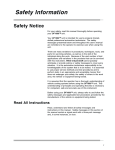Download Operations Manual - Flo
Transcript
TABLE OF CONTENTS INTRODUCTION to the VacFill3 .............................................. 2 SAFETY INFORMATION .......................................................... 3 SYSTEM FEATURES & SPECIFICATIONS ............................. 9 MACHINE OVERVIEW ............................................................ 10 OPERATING PROCEDURES for VacFill3 ............................... 13 OPERATING PROCEDURES for VacFill3+ ............................ 15 REPLACEMENT PARTS ......................................................... 17 MAINTENANCE ....................................................................... 19 CUSTOMER SERVICE CONTACT INFO ....................................... 19 WARRANTY INFORMATION ...................................................... 20 INTRODUCTION to the VacFill3 Congratulations on the purchase of your VacFill3 coolant service machine! The VacFill3 is a device that removes and refills engine coolant quickly and efficiently. Before the coolant is refilled, a vacuum is applied to the cooling system to eliminate any air in the system. Suddenly, cooling system maintenance has become a more realistic proposition. Fluid exchanges are cleaner and neater than ever! Service neglect causes engine coolant to break down which can lead to the engine freezing or overheating. Historically, cooling system fluid service has been neglected, often due to the lack of a convenient method for providing such flush or fluid exchange services. Please take time to read through this manual to familiarize yourself with the VacFill3 before performing your first coolant exchange. 2 IMPORTANT SAFETY NOTICE For your safety, read this manual thoroughly before operating this machine. Your VacFill3 unit is intended for use by properly trained, skilled professional automotive technicians. The safety messages presented below and throughout this user’s manual are reminders to the operator to exercise care when using this unit. Before using your VacFill3 unit, always refer to and follow the safety messages and applicable service procedures provided by the manufacturer of the vehicle being serviced. • Read All Safety Instructions Read, understand and follow all safety messages and instructions in this manual. Safety messages in this section of the manual contain a signal word with a three-part message and, in some instances, an icon. • Signal Words The signal word indicates the level of the hazard in a situation: Indicates an imminently hazardous situation which, if not avoided, will result in death or serious injury to the operator or to bystanders. Indicates a potentially hazardous situation which, if not avoided, could result in death or serious injury to the operator or to bystanders. Indicates a potentially hazardous situation which, if not avoided, may result in moderate or minor injury to the operator or to bystanders. Indicates a situation which, if not avoided, may result in damage to the machine, or the vehicle being serviced. • Safety Messages Safety messages in this section contain three different type styles: • Normal type states the hazard. • Bold type states how to avoid the hazard. • Italic type states the possible consequences of not avoiding the hazard. 3 • Safety Symbols A safety symbol, when present, gives a graphical description of the potential hazard, and how to avoid the hazard: 4 Risk of Fire Read Instructions Before Use Risk of Explosion Mandatory Eye Protection Risk of Entanglement Mandatory Protective Gloves Dangerous Fumes Mandatory Protective Clothing Do Not Pull or Move Risk of Burns IMPORTANT SAFETY INSTRUCTIONS Engine exhaust contains toxic gases. • Vent vehicle’s exhaust away from work area. • Do not breathe exhaust. Exhaust gases will cause injury or death. Improper use and operation. • Read, understand and follow all safety messages and operational procedures in this manual before operating this machine. • This equipment should be operated only by qualified personnel. • Use this equipment only as described in this manual. Improper use and operation of this product can result in injury. Engine systems can malfunction expelling fuel, oil vapors, hot steam, hot toxic exhaust gases and other flying particles. • Wear safety goggles and protective clothing, user and bystander. Everyday eyeglasses only have impact resistant lenses, they are NOT safety glasses. • Do not position head directly over or in front of carburetor or throttle body. Engine backfire can occur when air cleaner is out of normal position. • Make sure gauge reads zero before connecting or disconnecting hose connections to adapters. • Make sure cooling system pressure has been relieved before connecting or disconnecting hose connections and adapters. • Keep a dry chemical (Class B) fire extinguisher rated for gasoline, chemical & electric fires in the work area. Fire, explosion, or flying particles may cause serious injury. Risk of expelling pressurized fluids. • Wear safety goggles and protective clothing, user and bystander. 5 • Engine systems can malfunction, expelling fuel, oil vapors, hot steam, hot toxic exhaust gases and other debris. • Always unplug the machine from its power source when not in use. • Keep the service hoses away from hot or moving engine parts. Hoses can split or burst causing fluid to be expelled. • Avoid contact with engine coolant. • Treatment methods are as follows: Eyes: Flush eyes with plenty of water. Skin: Wash with soap and water. Inhalation: Move to uncontaminated area. Ingestion: If large amount, get medical attention. If any irritation persists, get medical attention. • Dispose of waste fluid according to environmental laws and regulations. Fuel, oil vapors, hot steam, hot toxic exhaust gases, pressurized fluid, and other debris can cause serious injury. Risk of unexpected vehicle movement. • Block drive wheels before starting vehicle’s engine to begin an exchange. • Unless instructed otherwise, set parking brake and put gear selector in park. • Do not leave a running vehicle unattended. • If vehicle has an automatic parking brake release, disconnect release mechanism for testing and reconnect when testing is completed. A moving vehicle can cause injury. Risk of entanglement. Engine has moving parts. • Do not place tools on fenders or other places in engine compartment. • Keep yourself, clothing, battery cables and service hoses clear of moving parts such as fan blades, belts, pulleys, hood and doors. • Barriers are recommended to help identify danger zones in test area. • Prevent personnel from walking through immediate test area. Contact with moving parts can cause injury. Risk of fire or explosion. • Do not operate in the vicinity of open containers of flammable liquids such as gasoline. • Keep hoses and jumper cables away from heat sources and sharp edges. • Do not operate equipment with damaged cords or hoses until they have been examined by a qualified serviceman. Fire or explosion can cause injury. 6 Risk of fire or explosion. Gases produced by a battery are highly explosive. • Wear safety goggles and protective clothing, user and bystander. • This machine is equipped to operate on 12-volt DC power only. A power source greater than this can result in serious injury to the user as well as damage to the machine. • Do not smoke, place metal tools on battery or allow a spark or flame in vicinity of battery. • Clean battery terminals before hooking the machine’s battery clips to them. During cleaning, keep airborne corrosion from eyes, nose and mouth. • Be sure both battery cables are tightly connected to the battery terminals as instructed before proceeding with a fluid exchange. • Never remove battery cables from the battery terminals while the machine is operating. Battery explosion can cause injury. Risk of burns. • Wear gloves when handling hot engine components. • Do not remove radiator cap unless engine is cold. • Pressurized engine coolant may be hot. • Do not touch hot exhaust systems, manifolds, engines, radiators, etc. Hot fluid and engine parts may cause injury. Battery acid is a highly corrosive sulfuric acid. • Wear safety goggles and protective gloves, user and bystander. • Have plenty of fresh water and soap nearby. If battery acid contacts skin, clothing, or eyes, flush exposed area with soap and water for 10 minutes. • While cleaning battery’s terminals, keep airborne corrosion from eyes, nose and mouth. • Do not touch eyes while working near battery. Battery acid can burn eyes and skin. Risk of burns. • Wear gloves when working near hot engine components. • Do not touch hot exhaust systems, manifolds, engines, radiators, etc. • The fluid coming from the vehicle along with some of the machine’s components that the fluid comes into direct contact with (i.e. hoses and fittings) may reach temperatures uncomfortable to the touch. Exercise caution in avoiding contact with these items. Hot components can cause injury or discomfort. 7 Risk of injury. • This equipment should be operated by qualified personnel only. • Use this equipment only as described in this manual. • Always unplug the machine from its power source when not in use. • Loop the power cord loosely in its proper location when machine is not in use. • Do not operate equipment with a damaged battery cables or hoses, or if the equipment has been dropped or damaged, until it has been examined by a qualified service representative. • Care should be taken to arrange the battery cables and service hoses so that they will not be tripped over or pulled. • Never pull on the power cables or service hoses to transport the machine. Damage may occur to these components, or machine may tip over. • Keep area of operation clear of unnecessary tools and equipment. Utilize recessed tool storage areas on the top of the machine. • Never leave the machine running unattended. 3 • The VacFill is not designed for any other purpose than the servicing of automotive cooling systems. Operation of this machine by anyone other than qualified personnel may result in injury. Misdiagnosis may lead to incorrect or improper repair and/or adjustment. • Do not rely on erratic, questionable, or obviously erroneous test information or results. If test information or results are erratic, questionable, or obviously erroneous, make sure that all connections and data entry information are correct and that the test procedure was performed correctly. If test information or results are still suspicious, do not use them for diagnosis. Improper repair and/or adjustment may cause vehicle or equipment damage or unsafe operation. Risk of equipment damage. • Connect battery cables to a 12-volt power source only (i.e. vehicle’s battery). • Servicing, transporting, or storing this machine in an attitude other than the normal operating position can result in fluid spillage and/or component damage. • Never pull on the power cables or service hoses to transport the unit. Damage may occur to these components, or machine may tip over. Always use the handle to move. • Periodically clean the machine by wiping down with a clean, soft, dry cloth. Improper operation of equipment may result in damage to machine or components. SAVE AND FOLLOW THESE INSTRUCTIONS! 8 DIMENSIONS & TECHNICAL SPECIFICATIONS DIMENSIONS: 52" Tall (VacFill3) 23" Wide 27" Deep Service Hose: 10’ outside of machine Wheels: 5” locking casters (front) 9 3/4” casters (back) Fluid Tanks: (2) 28-Quart New Fluid Tanks 28-Quart Waste Fluid Tank Weight: 3 160 lbs (VacFill ) 170 lbs (VacFill3+) TECHNICAL SPECIFICATIONS: Power: 115 psi Shop Air 12-Volt DC from vehicle battery (VacFill3+) Operating Temperature: 60º to 110ºF (15º to 43ºC) FEATURES • Durable roto-cast polyethylene body and tanks prevent vehicle damage • Ergonomically correct working height • 5” locking front caster wheels & 10” rear wheels allow easy maneuverability • Clear service hose allows visual confirmation of new and waste fluid movement • Easy access service panel 9 MACHINE OVERVIEW (VacFill3+ Shown) 10 11 MACHINE CONTROLS OVERVIEW Please take time to familiarize yourself with the VacFill3 controls before performing your first coolant exchange. The Main Control Panel is located on the front of the machine. VacFill3 Coolant Service Machine VacFill3+ Coolant Service Machine w/ Top-Off Feature Overflow Valve Located on the back of the machine 12 OPERATING PROCEDURES for VacFill3 IMPORTANT: Machine needs at least 115psi of air to operate. SUCTION WAND PROCEDURE: 1. Connect Wand Adapter to service line & open Ball Valve. 2. Turn Overflow Valve on back of machine to “Normal Service Position”. 3. Turn Right Dial to “Vacuum/Drain Waste” position. 4. Turn Left Dial to “Air On” position to start. 5. Turn Left Dial to “Air Off” position when finished. REMOVE & FILL PROCEDURE: 1. Make sure vehicle is turned off, but at operating temperature. 2. Turn Overflow Valve on back of machine to “Normal Service Position”. 3. Connect Wand Adapter to service hose, open Ball Valve, turn Left Dial to “Air On” position and Right Dial to “Vacuum/Drain Waste” position to remove waste fluid from overflow bottle. 4. When overflow bottle is empty, turn Left Dial to “Air Off” position. 5. Remove radiator cap. 6. Connect Cone Adapter to service line. 7. 8. 9. 10. Turn Right Dial to “Vacuum/Drain Waste” position. Turn Left Dial to “Air On” position. Open Ball Valve on service hose. Insert Cone Adapter into radiator, making sure the tip of the cone is submerged. HINT: If servicing from bottle, insert a hose into the cone long enough to reach near the bottom of the bottle (hose not supplied). 13 11. Wait until no more waste fluid is being removed. 12. Turn Right Dial to desired fluid type to fill the radiator making sure you don’t break the vacuum seal between the rubber cone & the radiator. 13. Turn Left Dial to “Air Off” position after fluid is removed. 14. Wait until new fluid stops entering radiator & remove Cone Adapter. 15. Top off radiator if needed. 16. Refill overflow bottle & replace radiator cap. DRAIN TANKS PROCEDURE: DRAIN WASTE TANK 1. 2. 3. 4. 5. 6. 7. 8. Turn Right Dial to “Vacuum/Drain Waste” position. Attach Wand Adapter to service hose. Turn Overflow Valve on back of machine to “Drain Waste Tank Position”. Open Ball Valve on service hose and place into waste container. Turn Left Dial to “Air On” position to drain waste tank. When finished draining, remove service hose from waste container, and close Ball Valve. Turn Left Dial to “Air Off” position. Turn Overflow Valve on back of machine to “Normal Service Position” to release air pressure from waste fluid tank. NOTE: Coolant may splash out while air pressure is being released. Keep hands and face away from the overflow bottle. 14 OPERATING PROCEDURES for VacFill3+ IMPORTANT: Machine needs at least 115psi of air to operate. SUCTION WAND PROCEDURE: 1. Connect Wand Adapter to Black Service Hose & open Ball Valve. 2. Turn Overflow Valve on back of machine to “Normal Service Position”. 3. Turn Right Dial to “Vacuum/Drain Waste” position. 4. Flip Switch to “Air On” position to start. 5. Flip Switch to “Off” position when finished. REMOVE & FILL PROCEDURE: 1. Make sure vehicle is turned off, but at operating temperature. 2. Turn Overflow Valve on back of machine to “Normal Service Position”. 3. Connect Wand Adapter to Black Service Hose, open Ball Valve, flip Switch to “Air On” position and Right Dial to “Vacuum/Drain Waste” position to remove waste fluid from overflow bottle. 4. When overflow bottle is empty, flip Switch to “Off” position. 5. Remove radiator cap. 6. Connect Cone Adapter to Black Service Hose. 7. Turn Right Dial to “Vacuum/Drain Waste” position. 8. Flip switch to “Air On” position. 9. Open Ball Valve on Black Service Hose. 15 10. Insert Cone Adapter into radiator, making sure the tip of the cone is submerged. HINT: If servicing from bottle, insert a hose into the cone long enough to reach near the bottom of the bottle (hose not supplied). 11. Wait until no more waste fluid is being removed. 12. Turn Right Dial to desired fluid type to fill the radiator making sure you don’t break the vacuum seal between the rubber cone & the radiator. 13. Flip switch to “Off” position after fluid is removed. 14. Wait until new fluid stops entering radiator & remove Cone Adapter. 15. Top off radiator if needed (see “Top-off Procedure”). 16. Refill overflow bottle & replace radiator cap. TOP-OFF PROCEDURE: 1. Connect Wand Adapter to Red Service Hose. 2. 3. 4. 5. 6. Make sure Ball Valve is closed. Turn Left Dial to desired fluid type. Flip Switch to “Pump On” position. Open Ball Valve at the end of the Red Service Hose to regulate fluid flow. Flip Left Dial and Switch to “Off” position when finished. DRAIN TANKS PROCEDURE: DRAIN WASTE TANK 1. 2. 3. 4. 5. 6. Turn Right Dial to “Vacuum/Drain Waste” position. Attach Wand Adapter to Black Service Hose. Turn Overflow Valve on back of machine to “Drain Waste Tank Position”. Open Ball Valve on Black Service Hose and place into waste container. Flip Switch to “Air On” position to drain waste tank. When finished draining, remove Service Hose from waste container, and close Ball Valve. 7. Flip Switch to “Off” position. 8. Turn Overflow Valve on back of machine to “Normal Service Position” to release air pressure from waste fluid tank. NOTE: Coolant may splash out while air pressure is being released. Keep hands and face away from the overflow bottle. 16 REPLACEMENT PARTS LIST Part # 941444W 941458 941448 941285 941438 941422 R941305 R941306 941439 941440 941277 941430 941274 941429 941450 941441 941346 941283 941431 941434 941432 941433 941424 941427 941425 942113 R942118 941300 P941321 941289 941295 941290 941291 941292 940988 940989 941396W 941442 Description Control Panel w/ Label (VacFill3) Control Panel w/ Label (VacFill3+) Wire Harness (VacFill3+) Fluid Pump (VacFill3+) Vacuum Gauge Upper Service Panel w/ Equipment List Label Lower Service Panel w/ Warning Sticker Measure Strip Label Vinyl Mat (Small Front) Vinyl Mat (Large Rear) 4-Way Ball Valve 2-Way Ball Valve Vacuum Generator Internal Hose Kit (VacFill3) Internal Hose Kit (VacFill3+) Black Service Hose Red Service Hose (VacFill3+) Black Plastic Body Red Plastic Top Waste Fluid / Air Tank (Steel) White Plastic Tank (L) White Plastic Tank (R) Overflow Bottle Overflow Valve Velcro Strap for Overflow Bottle Tank Cap Locking Caster Wheel 10” Wheel Shepherd's Hook Wand Adapter Cone Adapter Assembly Small Hose Clamp Pliers Medium Hose Clamp Pliers Large Hose Clamp Pliers Green Fluid Tank Label Red Fluid Tank Label Battery Cable Assembly Operations Manual 17 To order replacement parts for the VacFill3, call: 1-800-303-5874 18 MAINTENANCE To keep your machine working properly… • Keep debris out of new fluid tanks. • Avoid spilling fluid on the control panel. • Periodically wipe down exterior using a soft, damp cloth. CUSTOMER SERVICE CONTACT INFORMATION If you are experiencing problems with this machine, call technical support at: 1-800-303-5874 19 LIMITED ONE (1) YEAR WARRANTY Flo-Dynamics warrants only to the original Purchaser that under normal use, care and service, the Equipment (except as otherwise provided herein) shall be free from defects in material and workmanship for one year from the date of original invoice. External hoses, remote control modules, adapters and all other attachments, supplies and consumables (except as otherwise provided herein) are warranted for 90 calendar days from the date of original invoice. Filter elements are not warranted. Printed circuit boards purchased from, but not installed by Seller are not warranted. SELLER’S OBLIGATIONS UNDER THIS WARRANTY ARE LIMITED SOLELY TO THE REPAIR OR, AT SELLER’S OPTION, REPLACEMENT OF EQUIPMENT OR PARTS WHICH TO SELLER’S SATISFACTION ARE DETERMINED TO BE DEFECTIVE AND WHICH ARE NECESSARY, IN SELLER’S JUDGEMENT, TO RETURN THE EQUIPMENT TO GOOD OPERATING CONDITION. NO OTHER WARRANTIES EXPRESS OR IMPLIED OR STATUTORY, INCLUDING WITHOUT LIMITATION ANY IMPLIED WARRANTY OF MERCHANTABILITY OR FITNESS FOR A PARTICULAR PURPOSE, SHALL APPLY AND ALL SUCH WARRANTIES ARE HEREBY EXPRESSLY DISCLAIMED. This warranty does not cover (and separate charges for parts, labor and related expenses shall apply to) any damage to, malfunctioning, inoperability or improper operation of the Equipment caused by, resulting from or attributable to (A) abuse, misuse or tampering; (B) alteration, modification or adjustment of the Equipment by anyone other than Seller’s authorized representatives; (D) improper or negligent use, application, operation, care, cleaning, storage or handling; (E) fire, water, wind, lightning or other natural causes; (F) adverse environmental conditions, including, without limitation, excessive heat, moisture, corrosive elements, or dust or other air contaminants, radio frequency interference, electric power failure, power line voltages beyond those specified for the equipment, unusual physical, electrical or electromagnetic stress, and/or any other condition outside of Seller’s environmental specifications; (G) use of the Equipment in combination or connection with other equipment, attachments, supplies or consumables not manufactured or supplied by Seller; or (H) failure to comply with any applicable federal, state or local regulation. Repairs or replacements qualifying under this Warranty will be performed on regular business days during Seller’s normal working hours within a reasonable time following Purchaser’s request. All requests for Warranty service must be made during the stated Warranty period. This warranty is non-transferable. 20





















